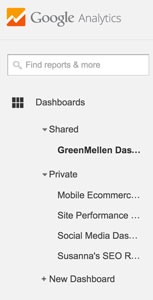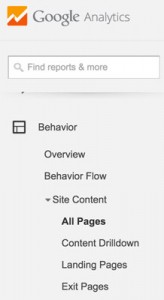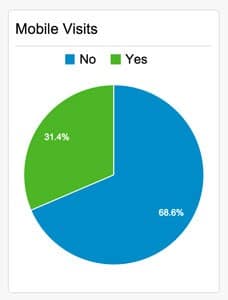Our All Things WordPress Meetup this month was a hands on walk through of Google Analytics and how to add demographics tracking to your Analytics panel.
Here are 8 reasons why you should be checking your Google Analytics:
1. See your site usage statistics at a glance.
 If there is data you want to see at a glance, be sure to set it up in the Dashboards area. Dashboards are great if you want to see an overview of your stats for traffic, goal completions, and other metrics all in one place. You can even change the date range on your dashboard and see all your widgets update to reflect the change. You can create several different dashboards, each set to reflect specific data. To create a new dashboard, simply go under “Dashboards” in the menu bar of your analytics and then select “New Dashboard” and add your widgets. Each type of widget can be filtered and customized to drill down to just the data you want to show. Google Analytics even has a dashboard library where you can import dashboards that are preconfigured. You can also share your dashboards — click here to download ours.
If there is data you want to see at a glance, be sure to set it up in the Dashboards area. Dashboards are great if you want to see an overview of your stats for traffic, goal completions, and other metrics all in one place. You can even change the date range on your dashboard and see all your widgets update to reflect the change. You can create several different dashboards, each set to reflect specific data. To create a new dashboard, simply go under “Dashboards” in the menu bar of your analytics and then select “New Dashboard” and add your widgets. Each type of widget can be filtered and customized to drill down to just the data you want to show. Google Analytics even has a dashboard library where you can import dashboards that are preconfigured. You can also share your dashboards — click here to download ours.
2. See where your visitors are located.

Are you kicking around the idea of pay per click advertising? If yes, you should know exactly where your visitors live, so that you can target your ads effectively.
Google Analytics lets you see all kinds of statistics on your audience, filtered by location, including average time on site and bounce rate. You can drill down from country, to state, and even to city. Targeting visitors in these locations with your ads will result in more goal completions for your site. See where your visitors are located in the Audience menu -> Geo -> Location.
3. See what keywords are bringing people to your site.
One of the most useful things you can do to create a more effective website is optimize your pages with keywords. A great starting point is learning what keywords are already being used to find you. You can find your current keywords in the Acquisition menu –> Campaigns –> Organic Keywords .
4. See what people are searching for on your site.
Site Search can help you determine what specific things people are looking for on your site. Use your site search results to examine what content should be added to your site to further engage your visitors. View your site search results in the Behavior menu -> Site Search -> Search Terms.
To see the site search results in Google Analytics, you’ll need to do some quick set up first. Here’s a quick screencast to walk you through the process.
5. Find out what content is working and what is not.
 Want to know which pages keep your visitors on your website the longest, or have the lowest bounce rate? What to see what pages are ignored by your visitors? You can see this quickly by going under the Behavior menu –> Site Content.
Want to know which pages keep your visitors on your website the longest, or have the lowest bounce rate? What to see what pages are ignored by your visitors? You can see this quickly by going under the Behavior menu –> Site Content.
Use the information from this area to refine your blog posts and landing pages to better engage your visitors.
6. Discover if you need a mobile site.
 Does it matter if your website is responsive? Find out by seeing how many site visits you receive from mobile devices in the Audience menu–> Mobile.
Does it matter if your website is responsive? Find out by seeing how many site visits you receive from mobile devices in the Audience menu–> Mobile.
On a side note, Google has said that sites that are not mobile device friendly will begin taking a rankings hit with the next search algorithm update. Contact us if you need changes made to your site to better engage your mobile traffic.
7. Are you meeting your Goals? Are you tracking your Goals?
Ask yourself what is the purpose of your website. Do you have an online store and you want to sell stuff? Do you have a blog where you make money from ads? Do you sell services or downloads? Once you’ve answered these questions, you can set up goals to track how your meeting your business objectives.
Here are some examples of goals to get you started:
- Store: shopper / sale goal – enable eCommerce tracking and check the conversion rates
- Blog: engagement visitor goal – people who spend more than one minute on your site
- Blog: reader goal – people who visit at least two pages on your site
- Service provider: calls to action goal – use event tracking to measure calls to action
- Online advertiser: use event tracking to measure top performing ads
Here’s a screencast on setting up a goal.
Once goals are set up, you can find your data in the Conversions menu –> Goals.
8. Know your Customers:
Since you as a business owner can not target your marketing strategies to individual consumers, demographics are the most useful method for marketing to groups of people with similar characteristics.
To find out more about your website customer, you’ll need to set up Demographic tracking on your website first. This short screencast will walk you through this process.
Once demographic tracking is set up, you can find your data in the Audience menu –> Demographics.
Slides:
Upcoming events
- March 12, 6:30 pm: Introduction to Child Themes: What, Why, How
- March 19, 11:30 am: Building a site that really works
- March 27 – 29: WordCamp Atlanta




